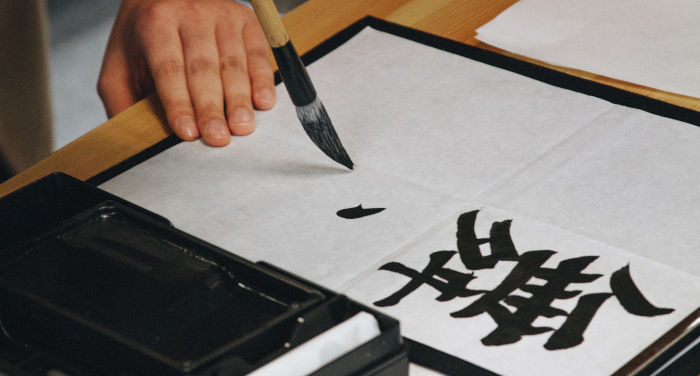
Chinese writing has a fascination all its own: from the ornamental aspect, which all can appreciate even without being an expert, to the symbolic value which is exotic to us, to the long tradition that the characters bring from over two millennia of history full of meaning and even magic.
There are those who don’t consider it so much as a form of writing the words of a spoken language as much as a system for “writing the world”.
In this article I will speak to you about the rules through which this “world” is created on paper: starting from an alphabetic writing you’ll be used to, up to simple signs that indicate sounds whose combinations create the written text, while the question becomes a little more complicated for Chinese.
Chinese writing – Index
Order and direction of writing
First of all, let’s disprove a common misconception: modern Chinese is written from left to right and from top to bottom, horizontally just like western languages.
The order of right to left vertically was used in the past (you can easily find books written in this way) and derived from the use of bamboo strips on which the first Chinese texts were written, and later by other “vertical” supports, but it is no longer used in everyday life.
This order from left to right and top to bottom is generally also maintained (which we’ll see later on) for the lines within a character.
Historically, characters are conformed into a square structure: it’s worth saying that, regardless of the number of lines that make it up, they will always take up the same amount of space within the text.
This did not happen in the early forms of Chinese writing where the more complex characters took up more space compared to those made up of fewer lines until regular writing (楷书 Kǎishū) regulated the proportions between characters.
Lastly, the characters are written without spaces between words and intervals are only for punctuation, which has been introduced only in relatively recent times (at the beginning of last century).
The strokes
The strokes are simply the dots (点 diǎn) and lines (线 xiàn) that make up the characters.
When talking about a stroke, in Chinese 一笔 (yībǐ), 一画 (yīhuà) or 笔画 (bǐhuà, also written as 笔划 with the same pronunciation), it refers to what is written each time the pen (笔 bǐ) or brush (毛笔 máobǐ) touches the paper up to when it is lifted from the page.
The two phases are respectively called 落笔 (luòbǐ) “resting the pen” and 起笔 (qǐbǐ), “raising the pen”. If the tool is not lifted from the medium on which it is written, it doesn’t matter how many curves the line has, it will always be just one stroke.
To give a quick example, one of the characters you learn to write very early on when learning Chinese and that you can mess up quite easily is 口 (kǒu), “mouth”: seeing it as a square, instinctively we’d draw it with four lines, while in reality it’s formed by three strokes, as you can see in the image below.
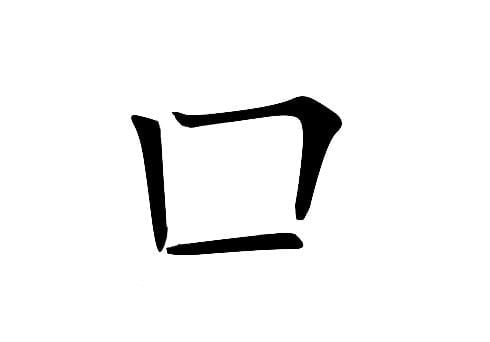
The first stroke is vertical to the left, followed by a type of upside-down L written without taking the pen off the page, and lastly the horizontal line that closes the square.
Often printed characters “flatten” the brushstrokes, making it difficult to distinguish the strokes; we’re not speaking then of handwriting, where various types of cursive tend to “fuse” everything together in a single sign that at first glance might seem little more than a scribble.
There are however various types of strokes: knowing them can help you distinguish them and improve your ability in reading and writing.
The classification of strokes
As was already mentioned, the stroke is the smallest unit that makes up a character. The ancient characters were not built according to the concept of a “stroke”; in the writing of seals 篆书 (Zhuànshū), for example, the shape of the strokes (笔形 bǐxíng) had curved lines and together it was difficult to distinguish when a single line started and ended.
From the writing of the scribes (隶书 Lìshū) onward the lines were standardized until reaching its present form. With regular writing (楷书 Kǎishū, going back to the Han Dynasty) the 永字八法 (yoňgzì bāfǎ) system was born, the “system of eight basic strokes contained in the character 永 (yǒng)”. This system is still used in calligraphy lessons (書法, shūfǎ).
Here’s a list of the eight strokes and their characteristics (see the figure below for a graphical example of each stroke):
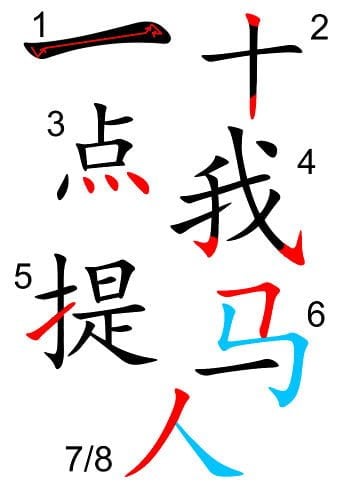
1. The horizontal stroke 横 (héng), one of the few strokes that is also a character on its own, the character for the number 1, 一 (yī). Although it’s often written as a simple horizontal segment, in handwriting and more accurate fonts you see two “bulges” at the end of the segment, caused by touching and raising the brush. While the first bulge is almost inevitable, in the lifting phase you can also end with a “dot” as in other strokes, in this case by mistake. There are at least two ways for getting the second “bulge”: the first is by regulating the pressure of the pen or brush, increasing the amount of ink used; other calligraphy teachers achieve this with a movement of the brush, which is raised diagonally up to the right, then down to the right and lastly returning to its horizontal stroke (you can see it in the image below).
2. The vertical stroke 竖 (shù) is simply a vertical segment. It always presents a bulge at the top due to the pressure of the brush, while below it finishes in a “dot” towards the right or left (even in printed fonts). It is found combined with the horizontal stroke 横 (héng), in the character for 10, 十 (shí).
3. The dot 点 (diǎn), from which the character gets its name, 点 contains a good 3 of these (the first, as we will see, is a different type of stroke). This isn’t a simple “point” with a circular shape; the brush is dragged a little toward the right to obtain an almost triangular form. It’s also seen in the number 6, 六 (liù).
4. The hook 钩 (gōu) can be added to other strokes by modifying the last part. To give two examples, the center vertical stroke 竖 (shù) in 水 (shuǐ) goes up into a point. The hook could be towards the right or left and usually follows the direction of the stroke that joins it. In the character 我 (wǒ) there are two: the first goes towards the left, the second to the right.
5. The rising stroke to the right or left end in a dot, 提(tí), is, in brief, a rising stroke that ends in a quick raising of the brush. In this way it creates a dot towards the top: you can see it in the character 提, the tilted stroke below the left part 扌.
6. The curvature 折 (zhé), which is also combined with other strokes, is what makes it hard to tell if it’s a single stroke or two connected strokes. How many strokes make up the character 马 (mǎ)? On instinct, we count at least 5, but really there are three: the first is a type of upside-down L, the second is the vertical-horizontal-vertical-hook, the third and last is the horizontal line in the center (you can see it more clearly in the image).
7. The descending stroke from right to left, ending in a dot 撇 (piě), like the righthand stroke in the character 人 (rén).
8. The descending stroke from left to right, which ends “flat” 捺 (nà), as in the second stroke of 人 (rén).
In 1988 the 现代中文通用字表 (Xiàndài Zhōngwén tōngyòng zìbiǎo, “table of commonly used characters in modern Chinese”) consolidated, among other things, the categories of Chinese strokes, which from eight became five.
In this new classification, 点 (diǎn) and 捺 (nà) have been reunited into a single category, because both are strokes descending to the right or left, differentiated only by their length; 横 (héng) and 提 (tí), at the same time, they were merged; lastly, 折 (zhé) and 钩 (gōu) became a single type of stroke that doesn’t have a curve.
This new method was called “札” 字法 (“zhá” zìfǎ). The new strokes are:
- 竖 (shù) vertical stroke;
- 撇 (piě) curving stroke descending to the right or left ending in a point;
- 点 (diǎn) (also includes 捺 nà) descending stroke to the right or left ending flat;
- 横 (héng) (also includes 提 tí) horizontal/lightly rising stroke ending flat or in a point;
- 折 (zhé) (also includes 钩 gōu) strokes with at least one curve/hook.
In this case, it makes the distinction between the “normal” shapes 主笔形 (zhǔbǐxíng), which are those that appear in standard positions, and the variants 附笔形 (fùbǐxíng), which show up in particular positions; in this way 捺 (nà), 提 (tí) and 钩 (gōu) are considered variants, respectively of 点 (diǎn) (a longer version), 横 (héng) (a version that finishes in a point, slightly tilted) and 折 (zhé) (a “final” bending).
These types are also divided into two groups: the first four are the so-called 单一笔画 (dānyī bǐhuà), the “single” strokes; the second category, 复合笔画 (fùhé bǐhuà), are part of all those included in the 折 (zhé) type, the “compound” stroke, which however can present so large a variation so as to be divided into 4 groups themselves (for the number of “folds”) and 25 types of strokes.
You’ll find all the types of new classifications below: observing the characters to discern the common stroke can be a useful exercise for learning to tell them apart, but if you simply want to continue reading jump directly to the next part.
横 (héng):
平横 (píng héng) flat horizontal stroke: 工 平 天 干
提横 (tí héng) rising horizontal stroke: 拉 场 理 地
竖 (shù):
短竖 (duǎn shù) short vertical stroke: 师 临 坚 归
长竖 (cháng shù) long vertical stroke: 干 丰 中 车
竖钩 (shù gōu) hooked vertical stroke: 小 打 添
撇 (piě):
卧撇 (wò piě) horizontal descending stroke to the left: 千 舌 兼 乔
竖撇 (shù piě) vertical descending stroke to the left: 月 川 头 周
长撇 (cháng piě) long descending stroke to the left: 刀 无 勿 为
短撇 (duǎn piě) short descending stroke to the left: 面 白 舟 北
点 (diǎn):
短点 (duǎn diǎn) short descending stroke to the right: 商 母 兴 鬯
长点 (cháng diǎn) long descending stroke to the right: 双 头
挑点 (tiǎo diǎn) rising stroke to the right: 河 求 冷 凉
左点 (zuǒ diǎn) descending stroke towards the left on the left: 办 刃 心 必
平捺 (píng nà) horizontal descending stoke from left to right: 之 廷 这 走
斜捺 (xié nà) tilted descending stroke from left to right: 又 义 个 人
5. 折 (zhé):
With a single bend
横折 (héng zhé) horizontal stroke with bend (an upside-down “L”): 口 团 马
横撇 (héng piě) horizontal stroke followed by a descending stroke to the left: 水 夕 了
横钩 (héng gōu) horizontal stroke with hook: 饮 买 家
竖折 (shù zhé) horizontal stroke that bends (similar to an L): 母 函 山
竖弯 (shù wān) vertical stroke that curves: 四 西
竖提 (shù tí) vertical stroke that rises: 长 叫 瓜
撇折 (piě zhé) descending stroke to the left followed by a bend: 么 红 乡
撇点 (piě diǎn) descending stroke to the left followed by a descending stroke towards the right: 女 巡
撇钩 (piě gōu) hooked descending stroke to the left: メ (Japanese character not present in Chinese)
弯钩 (wān gōu) curved stroke with hook: 狄 犹
斜钩 (xié gōu) descending stroke from left to right with hook: 我 曳 代
With two bends
横折折 missing 凹 卍
横折弯 (héng zhé wān) horizontal stroke followed by a bend and a curved stroke: 朵铅
横折提 (héng zhé tí) horizontal stroke followed by a bend and a rising stroke towards the right: 讨 论 计
横折钩 (héng zhé gōu) horizontal stroke followed by a bend and a hook: 刀 同 门
横斜钩 (héng xié gōu) horizontal stroke followed by a curved stroke descending from left to right and a hook: 飞 凤 执
竖折折 (shù zhé zhé) vertical stroke followed by two curves: 鼎 卍 亞
竖折撇 (shù zhé piě) vertical stroke followed by a curve and a curving stroke descending toward the left: 专
竖弯钩 (shù wān gōu) vertical stroke followed by a curve and a hook (also 卧钩 wò gōu, “extended” hook): 也 电 心 必
With three bends
横折折折 (héng zhé zhé zhé) horizontal stroke followed by three bends: 凸
横折折撇 (héng zhé zhé piě) horizontal stroke followed by two bends and a descending stroke towards the left: 建 廷 及
横折弯钩 (héng zhé wān gōu) horizontal stroke followed by a bend, a curved stroke and lastly a hook: 九 匹 艺
横撇弯钩 (héng piě wān gōu) horizontal stroke followed by a descending stroke towards the left, a curve and lastly a hook: 陈 降 都
竖折折钩 (shù zhé zhé gōu) horizontal stroke followed by two curves and a hook: 考 马 号
With four bends
横折折折钩 (héng zhé zhé zhé gōu) horizontal stroke followed by three bends and a hook: 乃 杨
When little Chinese children start learning 汉字 (Hànzì), Chinese characters, they already know how to speak and write the pronunciation in 拼音 (pīnyīn), that is using the letters from the Latin alphabet with the addition of tonal indicators; they later learn to write the characters corresponding to the spoken language.
A fundamental phase is when they study the names and shapes of the strokes that make them up: thanks to these it’s possible to graphically “build” all existing characters, like “bricks” in a different shape to combine into different ways to obtain a final “construction”. With the names you’ve seen up until now, the teacher can “dictate” a character by voice, stroke by stroke.
It’s important to note that the strokes, even if they have a name (which mainly serves to identify them when asked to write a specific stroke or describe the process of writing a character), do not have a sound: they are just a series of graphic symbols put together to make a character.
The combination of strokes
The strokes that you’ve seen above, both the simple and more complex ones, can be combined in three ways:
相离 (xiāng lí) detached: the strokes don’t touch
Examples: 八二三仁小心儿
相接 (xiāngjiē) connected: the strokes touch in just one place
Examples: 人入上工久山口
相交 (xiāngjiāo) intersecting: the strokes cross each other
Examples: 九又干十七丰世
The majority of characters are written by combining two or more of these types of strokes.
For example, 干 (gān) and 天 (tiān) are formed by both connected and intersecting strokes; 么 (me) and 亿 (yì) have both connected and unconnected strokes; 义 (yì) and 斗 (dǒu) have detached and intersecting strokes; 犬 (quǎn) and 丹 (dān) have detached, connected and intersecting strokes.
Combined in different ways, the same strokes can form different characters:
人 (rén) – 八 (bā)
几 (jī) – 九 (jiǔ)
刀 (dāo) – 力 (lì)
The order of strokes
The order of strokes to write in sequence in order to correctly make a character is called 笔顺 (bǐshùn). This is a conventional system standardized by use, so for each character, there exists a correct and standard order to follow.
Numerous sites and apps like Pleco and Zdic, just to cite a few, like all Chinese manuals, show the correct order of strokes to write the characters.
Characters are square-shaped symbols, and regardless of how many strokes they’re made up of, they’re placed in a symmetrical and balanced way. The majority of these have a “center” that is easily recognizable around which the other parts are arranged.
There are a few main rules of writing, in part dependent on the structure of the character itself, which are often subdivided into parts generically called roots.
Roots can be formed by one or two strokes, and are a further help for memorizing the order of strokes in that they are fixed parts that are repeated equally in lots of characters. To go deeper into the structure of characters, there’s another article here, that I recommend that you read before moving on.
Some of these rules are very generic and apply to many characters while others are limited to certain types:
- 从上到下 (cóng shàng dào xià), from top to bottom. This rule goes for characters formed by multiple strokes, such as the numbers 二 (èr) and 三 (sān): The strokes are written from top to bottom. Some characters are then divided into overlapping “parts”: in that case, you first complete the upper part and then go on to the lower one, such as in the characters 旦 (dàn), 星 (xīng) and 军 (jūn).
- 从左到右 (cóng zuǒ dào yòu), from left to right. When it’s a vertical stroke, the ones on the left are written before those on the right first, as in 人 (rén) or 八 (bā). When the characters are formed by parts side by side, you still go from left to right, completing one component at a time, as in the characters 明 (míng), 打 (dǎ) and 谢 (xiè).
- 先横后竖 (xiān héng hòu shù), first the horizontal stroke and then the vertical one. When there are characters where two strokes intersect, the horizontal is written first before the vertical one. Some examples are 十 (shí), 干 (gān) and 王 (wáng). Keep in mind though that rule number one still applies: if there’s a top stroke it gets written first.
- 先撇后捺 (xiān piě hòu nà), first the descending stroke to the left, then the descending stroke to the right. Some examples are: 入 (rù), 分 (fēn).
- 从外到内 (cóng wài dào nèi), from outside to inside. In characters where a “frame” appears, it gets written before everything that it includes, such as in the characters 周 (zhōu), 问 (wèn) and 用 (yòng).
- 从外到内后封口 (cóng wài dào nèi hòu fēngkǒu), first the outside, then the inside, then close. When the “frame” is closed at the bottom, you first write the outside part, then what’s inside and lastly close the frame with the last stroke below. Some examples: 田 (tián), 目 (mù), 国 (guó).
- 先中间后两边 (xiān zhōngjiān hòu liǎngbiān), first the center part and then the two sides: in some particularly structured characters, you first write the center part and then the left and right, almost like adding branches to the trunk of a tree. Not by chance, 木 (mù), wood (which in the past meant, tree), is written like this, also like 小 (xiǎo) and 水 (shuǐ).
- 先中间后加框 (xiān zhōngjiān hòu jiākuàng), first the center and then the frame: similarly, some characters have this particular structure with a center part and a frame below. In this case, the center part is written first, followed by the frame. Here are some examples: 山 (shān), 凶 (xiōng), 幽 (yōu).
To simplify, here are the basic rules for Chinese characters:
- In a square
- From left to right
- From top to bottom
- Standard components
These are just the general rules, which in reality have a good number of exceptions. I’ve gathered some of the most common ones (and as a result, they’re probably among the characters most often written badly), which you’ll find in the image below; if you want, you can practice the rules we’ve already seen to see which are the ones contradicted by each of these:
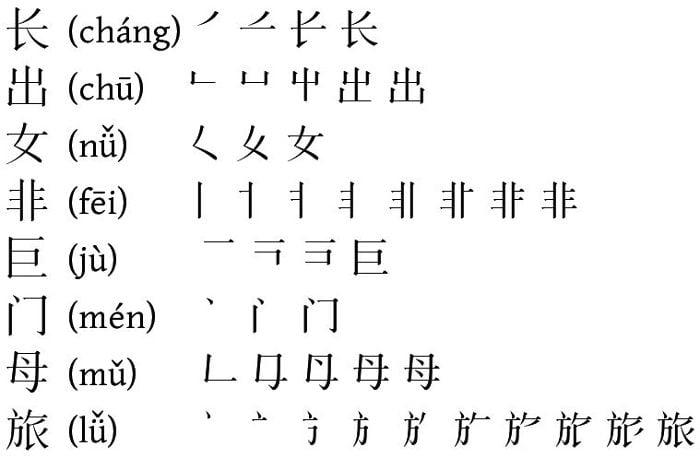
Why learn the order of strokes?
Learning and respecting the order of strokes has various advantages. First of all, it speeds up the process of writing and makes it possible to write more elegant, understandable, and harmonious characters; moreover, if you know the sequence of strokes it will also be much easier to read cursive, which is the everyday writing used by the Chinese where (despite everything I explained up to now…) the strokes are joined, curved and almost unrecognizable.
Knowing how to count the strokes is useful for looking up characters in the dictionary with its system of roots, but also to use in all situations where you would need to know how to count the strokes, such as resolving puzzles and riddles, or choosing a Chinese name so as to get one with an auspicious number of strokes.
Knowing how to distinguish the strokes allows you to take advantage of the best programs and apps that allow for inserting characters by hand (which now also recognize the most common errors). Finally, it allows you to write characters even if you don’t know the pronunciation or meaning, with greater accuracy.
A few times, on the metro in Shanghai, I also noted people writing characters by hand on their cell phones while sending messages on WeChat, even though I don’t know if it could be a quicker method of input than the pinyin that everyone normally uses, but rather a way for practicing their writing (you can always try… for sure it’s a good way to keep from forgetting the characters!).
As you’ve seen, despite all the rules and complications (or perhaps because of them) Chinese writing is without a doubt one of the most fascinating characteristics of this culture. I hope that this article has helped you know it a little bit better!
Curiosities
To conclude, I leave you with a few curiosities (if you have others, add them in the comments!):
- According to a statistic made on 7000 common characters, each character has on average 10.75 strokes; the same statistic showed that among the characters considered, the largest group is made up of 9 strokes, which are a good 785 of 7000.
- The characters formed by the least strokes are 一 (yī) and 乙 (yǐ), formed by just one stroke; the one with the most strokes is 齉 (nàng) with 36 strokes.
- However there is a character called biáng, which refers to a type of tagliatelle that’s a specialty of Shaanxi 陕西 (Shǎnxī), biángbiángmiàn, (–面) it’s so complex that it can’t be written on a computer (there are 58 strokes in traditional Chinese, “just” 42 in simplified Chinese). You can see it here.
Photo Credits: Photo by Niketh Vellanki on Unsplash
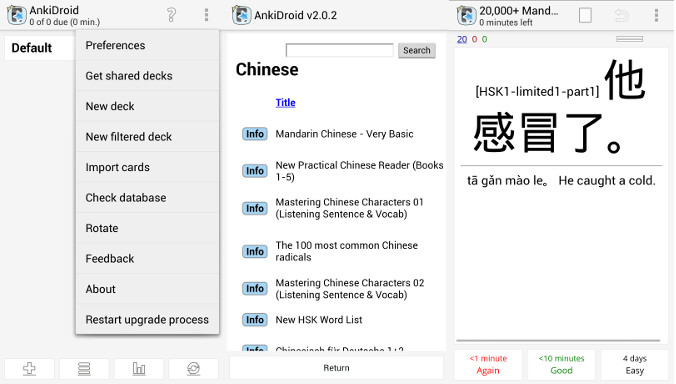

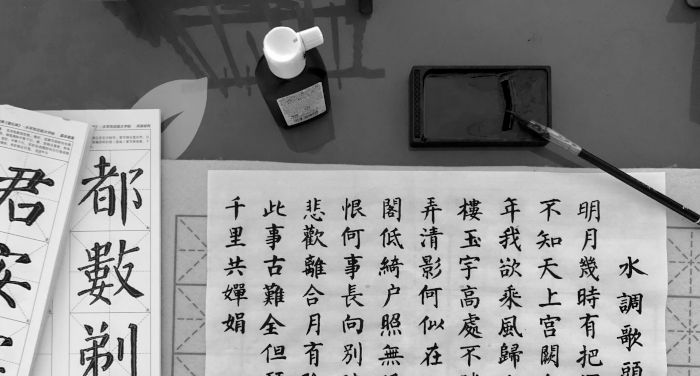

先横后竖 (xiān héng hòu shù), first the vertical stroke and then the horizontal one. When there are characters where two strokes intersect, the vertical is written first before the horizontal one….
I supposed it should mean the other way around, first the horizontal stroke and then the vertical one.
You are right! Thank you for the feedback, I’ve already corrected the sentence